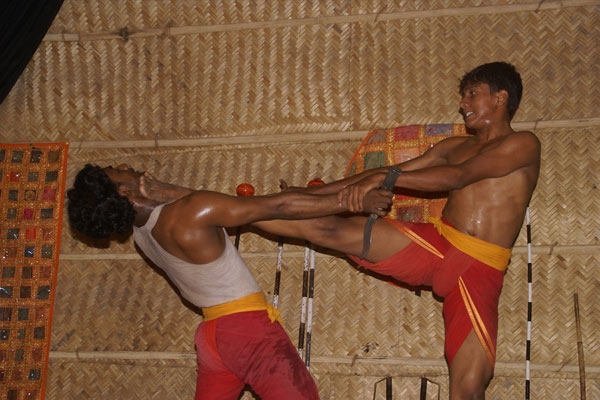Martial Arts Near Me
Kalaripayattu
Kalaripayattu, the ancient martial art form of Kerala, India, is believed to be one of the oldest combat systems in existence. With a rich history spanning over several centuries, Kalaripayattu has evolved and adapted, blending physical conditioning, weaponry, and self-defense techniques. Today, it stands as not only a martial art but also as a cultural emblem representing the heritage and traditions of Kerala.
The origins of Kalaripayattu can be traced back to the 3rd century BCE, making it a testament to the ancient combat arts of India. Derived from the words "Kalari" meaning "battlefield" and "Payattu" meaning "practice," Kalaripayattu was initially developed with the aim of defending kingdoms from invaders. Through the centuries, this martial art form found its way into the Hindu temples, attracting practitioners seeking a spiritual connection along with physical mastery.
The history of Kalaripayattu is steeped in legends. One such legend tells the story of Parashurama, an avatar of Lord Vishnu, and the legendary Guru of Kalaripayattu. It is said that Parashurama, upon witnessing the destruction caused by war, created Kalaripayattu to instill discipline, physical fitness, and self-defense skills in people to avoid unnecessary bloodshed. Another legend speaks of Dronacharya, the revered teacher of the Pandavas in the epic Mahabharata, who is believed to have been a master of Kalaripayattu.

The techniques of Kalaripayattu are vast and encompass a comprehensive range of physical movements, strikes, kicks, grappling, locks, and weaponry. Primarily divided into four stages – "Meippayattu" (body conditioning), "Kolthari" (stick-fighting), "Angathari" (weapon-fighting), and "Verumkai" (unarmed combat), Kalaripayattu demands immense physical agility, dexterity, and mental focus.
Body conditioning plays a crucial role in Kalaripayattu. It involves rigorous exercises, such as "Marichil" (jumping exercises), "Kozhuthinodi" (forward and backward movements), and "Meduvandan" (bending exercises), which enhance flexibility, endurance, and strength. This stage prepares the practitioner for the complexities of combat and paves the way for the subsequent stages.
Stick-fighting or "Kolthari" in Kalaripayattu is a unique aspect of the art. It involves the use of a wooden stick or "Ottakol" made from the dense core of a palm tree. Practitioners engage in various attack and defense techniques, incorporating strikes, spins, blocks, and sweeps. The objective of this stage is to develop precision, coordination, and footwork, while also nurturing an acute sense of timing and distancing.
The "Angathari" stage focuses on weapon-fighting encompassing a wide array of weapons, including swords, spears, daggers, and flexible weapons like the "Urumi." The techniques taught in this stage are detailed and intricate, requiring years of practice to master. Weapon-fighting in Kalaripayattu demands not only proficiency in offensive and defensive maneuvers but also an understanding of the weapon's unique characteristics, weight, and balance.
However, while Kalaripayattu emphasizes weaponry, it is not limited to it. The "Verumkai" stage, meaning "empty hand," allows practitioners to develop their skills in unarmed combat. This aspect of Kalaripayattu involves strikes, kicks, locks, throws, and grappling techniques, emphasizing joint manipulations and pressure point strikes. The training in Verumkai serves as the foundation for practitioners to defend themselves through self-defense mechanisms without any external aids.
The current status of Kalaripayattu is a blend of tradition and modernity. Although it faced a period of decline due to colonial rule and changing social dynamics, efforts to revive and promote this ancient art form have been successful over the past century. Kalaripayattu schools known as "Kalari Gurukkals" have sprung up across Kerala and other parts of India, preserving the art through dedicated practitioners and teachers.
Furthermore, Kalaripayattu has garnered global recognition, attracting both enthusiasts and scholars from around the world. Several international organizations and forums promote Kalaripayattu as an integral part of India's cultural heritage and offer training programs, workshops, and performances to spread awareness and appreciation for this unique martial art style.
In recent times, Kalaripayattu has also gained popularity in the entertainment industry. Its dynamic movements, acrobatics, and skillful weaponry have found their way into cinema, dance performances, and stage shows, captivating audiences worldwide. This exposure has played a significant role in not only preserving the essence of Kalaripayattu but also introducing it to new generations, ensuring its continuity in the modern era.
Kalaripayattu, the ancient martial art of Kerala, stands as a testament to India's rich cultural heritage. Its origins, techniques, and current status all contribute to its unique identity. As an art form that combines physical conditioning, weaponry, and self-defense techniques, Kalaripayattu serves as a reminder of our historical legacy, while also evolving to meet the demands of the contemporary world.